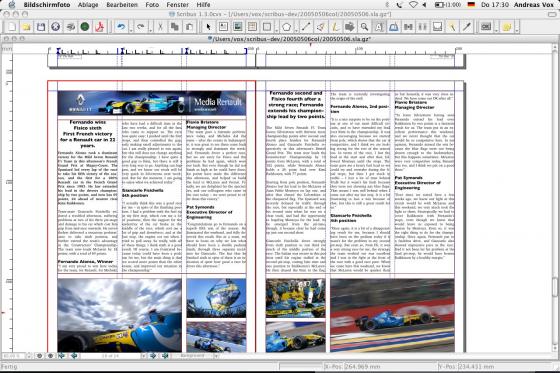
As a professional quality, page layout app that can create "press-ready" digital files, Scribus is becoming the alternative option of many designers and graphic design artists who work in publishing and print.
Scribus has a feature set that covers all the essentials of pre-press page lay out design: CMYK
color, separations, ICC color management and highly useful PDF creation functions.
You may sync image manipulation via GIMP, another open source app that is the equivalent of Adobe Photoshop and almost as fully-featured as of this writing. Scribus can also import from and export document files to programs in the Open Office suite. The user interface is actually tuned to artist's workflow than the seemingly slicker interface of branded DTP apps, and you can custom skin the Scribus front end to fit the look of your OS. For the novice DTP user, Scribus offers plenty of pre-built templates and additional 'Scribus proprietary templates' that can be downloaded from the site's repository. Get even more FREE templates, fonts, and scripts at ScribusStuff.
As an open source product, you get complete documentation of all the DTP workflow features and tons of priceless support from Scribus's seasoned digital-user fan base, who are typography artists and expert page-layout, graphic designers themselves.
Save Money, Go Open Source
Start-up publishing studios or print shops looking to
save money on new and expensive services should always opt for available open source tools. Learning from hands-on work processes and in-house resources reduces costs enormously for print and publishing workplaces. Open source tools like Scribus allow everyone an opportunity to DO desk-top publishing for a ten-fold fraction of the cost of going branded software. In-house production of company brochures, newsletters and documents will provide better savings than outsourcing them.
User Workflow
When you launch Scribus, a template window boots up showing options for what kind of New Document you will be working on: Single-page. Double-sided. 3-fold. And 4-fold
options. Clicking New from Template tab offers more choices for work area settings (your page dimensions). You get dozens of template options from the installed the templates package and can get more from the repository.
To fit images inside your document, the "Adjust Image to Frame" and "Adjust Frame to Image" automatically sizes and scales digital pictures to fit your page workspace. You drop the image and text body onto a grid like normal DTP apps, then set shapes, lines, frames, and more into place in your document. Like the manual cut and paste mock up process, just Insert your preferred element onto the grid and then edit as desired. You can even set the main window to show as many pages as you can handle if you like to see everything in one sweep.
Free Tutorials
There are plenty of online FREE resources of lay-out artist showing you how to use Scribus on a blank sheet of paper. You can pick up things faster by watching a You Tube video and go from there. Getting hang of the different front end might takes a little time if you are used to working with Indesign or another branded DTP app, but the Scribus workflow grows on you and even gets you more productive sessions.
Bundled with Gimp on Ubuntu Studio!
Scribus shares files with other open source apps used for desktop publishing like Libre Office or gFlyers and is often bundled with GIMP (a digital image manipulation app) in Ubuntu Studio and similar creative Linux distros. Scribus can automatically be configured to send images to GIMP (if installed) when you edit images by clicking on them. If you were looking for a Linux Distro that runs very good package of open source graphic design apps and desk top publishing apps, you might prefer Ubuntu Studio. Or download and install Scribus into your Linux Distro of Choice. It also works on Windows and Mac as does GIMP and both open source apps are still FREE.



